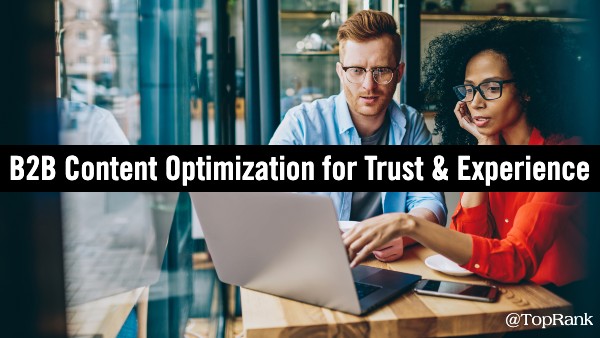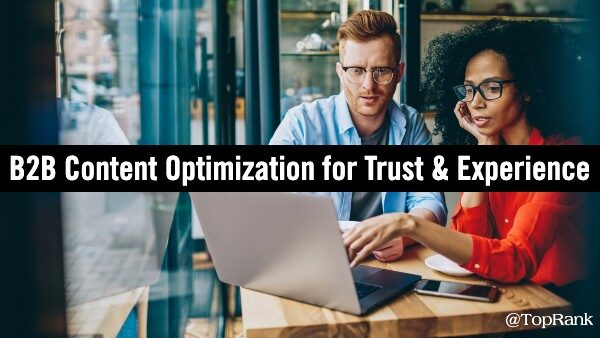
As the world’s most popular search engine, Google says its mission is to “Organize the world’s information and make it universally accessible and useful.”
To be the best answer for customers that are looking for solutions, B2B marketers need to understand the opportunities to make information easy for search engines to find, index, and sort in search results.
A big part of optimizing the customer’s search experience is understanding myriad data sources and file types that can be included in search results. By understanding these opportunities, B2B marketers can inventory their digital assets and create a better, more holistic SEO strategy that realizes the benefit of inclusion and visibility in all the places and formats that matter to customers who are looking.
What Can Be Searched Can Be Optimized
Successful B2B marketers approaching the business of optimizing content for better visibility on search engines do so holistically under the premise, “What can be searched can be optimized.” That means more attention is being paid to the variety of reasons people search as well as the variety of reasons companies publish searchable content. Content, SEO and industry influencers are perfect partners for making it easy to connect any audience with a company through findable and credible content.
The practice of SEO involves both content creation and curation as much as it does with reworking existing content. When marketers examine the search results page of targeted keyword phrases on a regular basis, review web analytics, and conduct social media monitoring, they can gain a deeper sense of what new sources, people, conversations and content types can be leveraged for better search visibility.
Monitoring search results can show that the keyword terms being targeted may trigger different types of content or sources of influence than previously relied on. For example, certain search queries might be prone to triggering images and video, not just web pages. Or a top source of influence for a topic might be an academic vs. an analyst. Understanding of the search results landscape for a target keyword phrase is essential for allocating content creation and keyword optimization resources. The payoff? A better search and content experience for customers at the very moment of need.
For many companies, it can seem difficult to implement a more holistic content marketing, influence and search optimization program. Substantial changes may be necessary with content creation, approval, and publishing processes. But the upside is that an increase in the right types of content, influencers and media indexed and linking to a company website can provide both search engines and customers the options they need for the best experience.
As long as there are search engines, and search functionality on websites, there is an opportunity to improve marketing performance of content in search. Marketers need to consider all the digital assets, content, sources of influence and data they have to work with to give both search engines and customers the information they’re looking for in the formats they’ll respond to.
Optimize For Customers
No doubt, you’ve searched and found web pages that were clearly “optimized” in the name of SEO. That kind of copy might help a page appear higher in search results but doesn’t do much for readers once they click through.
With increasing emphasis on business customer experience, the importance of optimizing for customers and user experience couldn’t be higher. Technical SEO will always have a role, but working together with optimization efforts that go beyond search visibility to search experience is what creates a competitive advantage to deliver best answer content when it matters most.
Creating, optimizing, and promoting content based on customers’ interests that leads them to a purchase makes the most out of both useful content, influencer marketing and SEO best practices. Great SEO copywriting doesn’t read as a list of keywords, but instead balances keyword usage with creative writing that appeals to the reader, thus educating, influencing, and inspiring action. In fact, the best optimized content is also the best user experience.
Marketers need to take a step back and review which audience and outcomes they are optimizing for: search engines and rankings or customers and sales. What about all of the above?
Optimize For Experiences
Savvy B2B marketers don’t see content simply as an SEO tactic but as a proxy to creating better customer experiences. Content is the mechanism for storytelling, and if search optimization and influencer marketing are also involved in a qualitative way, they aid in discovery and sharing of those stories.
In an integrated content/influence and optimization model for B2B marketing, we emphasize an understanding of customer needs and behaviors through ideal customer profiles and attention to variances during the full customer lifecycle from awareness to advocacy. Those insights, combined with ongoing monitoring and collaboration with internal and external subject matter experts, drives content marketing strategy and the creative mix of content assets designed to help prospects have meaningful experiences with the brand.
With this attention, content itself is made easier to discover in more relevant ways through search engine optimization and more credible with contributions from key opinion leaders and industry experts. A “findable and credible” approach to content marketing increases the connections between consumers who are searching and influenced on topics of relevance to the brand solution.
Great Content isn’t Great Unless it’s Findable and Credible
Proliferation of brand messages on social media with scheduled tweets, status updates, livestream videos, stories and blog posts alone is not engagement. And alone, that kind of content certainly does not create the kind of experience that builds brand or motivates customers to buy, be loyal, or advocate.
From an overall marketing and customer engagement perspective, all content is not created equal. Any kind of content isn’t appropriate in any kind of situation. Since much of the focus of B2B marketing is on customer acquisition, many SEO efforts emphasize transaction or lead generation outcomes. That’s what they’re held accountable for. Unfortunately, search to purchase or influencer to purchase are not the only ways people interact with information online. Research before purchase and education and support afterward are increasingly important as B2B buyers rely more on digital content than ever to educate themselves.
While publishing content on a regular basis better than not creating any content at all, it’s a much more effective thing to be purposeful in content creation and marketing according to the full customer experience. Seeing content engagement opportunities holistically can provide a company more ways to initiate, maintain, and enhance customer relationships. Including industry influencers in that content also adds more credibility and trust to that brand content.
In the development of a content marketing strategy, there are numerous opportunities to be more relevant, trusted and effective. Planning content that’s meaningful to the customers you’re trying to engage according to where they are in the buying cycle and overall customer relationship provides greater efficiency in content creation, collaboration with industry influencers and for repurposing content.
Go Holistic with B2B Content or Go Home
Holistic content marketing and editorial planning also help make better use of tactics that transcend the relationship timeline. It’s especially the case with holistic SEO and influencer marketing that content producers can extend their reach and visibility to customers who are looking to engage with brands in other ways besides simply purchasing a product. B2B marketers that do not consider creating credible content experiences after the sale are missing out on substantial opportunities to serve customers and subsequently, generate increased revenue.
By considering the content needs across the customer life cycle, not just acquisition or conversion, companies can become significantly more effective and efficient in their ability to connect relevant, trusted messages and stories with customers who are interested. The result: shorter sales cycles, better customer relationships, and greater trust.
(Portions of this post were adapted from my book Optimize: How to Attract and Engage More Customers by Integrating SEO, Social Media and Content Marketing – Wiley)



